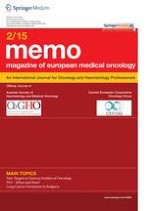01.06.2015 | review
The relevance of positron emission tomography response in non-small cell lung cancer
Erschienen in: memo - Magazine of European Medical Oncology | Ausgabe 2/2015
Einloggen, um Zugang zu erhaltenAbstract
Background
Most patients treated for lung cancer experience disease recurrence or progression, resulting in high mortality rates. Computed tomography (CT) is central in evaluating treatment response; however, positron emission tomography (PET) may provide a more rapid and prognostically relevant assessment of changes in disease activity during and after treatment.
Methods
We present a case which illustrates the potential role of PET in assessing treatment response in non-small cell lung cancer (NSCLC) and review the relevant literature.
Results
A 49-year-old woman presented with an inoperable pancoast tumour of the lung and was treated with radiochemotherapy (RTCT). PET-CT showed that, while her tumour had not changed in size, the metabolic activity of the tumour had decreased significantly following RTCT. The decision was made to resect the tumour, which was found to contain only a small cluster of viable tumour cells. This case illustrates the clinical relevance of assessing metabolic tumour response in addition to morphologic tumour response. Clinical studies have shown PET to be a valuable addition to treatment response assessments performed using CT in a wide range of clinical situations. Following surgical treatment PET is more effective than CT alone in identifying recurrence, and may be useful in differentiating postoperative scar tissue from active tumour. During systemic treatment, whether with chemotherapy or EGFR-TKIs, the early metabolic response seen in PET can be predictive of the degree of clinical benefit.
Conclusions
In addition to the structural information provided by CT, the metabolic information from PET during or following treatment for NSCLC is increasingly valuable in clinical decision making.
Anzeige
